Wednesday, February 19, 2003
Up at 5:15 to await a 6:00 a.m. bus. Today we
travel to Flores, Guatemala, and visit the Mayan
archeological sites of Bonampak and Yaxchilán along
the way. We are traveling with a group in order to
expedite our journey. In our minivan are 12 friendly
passengers (all gringos), a driver, and a helper. We
met an English guy, Nick, who we would continue to
bump into over the next few days.
Almost as soon as you leave Palenque the road
begins to climb and you enter much denser vegetation.
This fine blacktop road interrupting the Selva
Lacandóna and enabling our journey comes courtesy of
the Mexican government, who only in recent years
built the road to surround and penetrate the forest
where the Zapatistas move. Regrettably, this
accessibility has brought an influx of settlers, and
much of the forest has been replaced by
sickly-looking pasture, having recently been slashed
and burned.
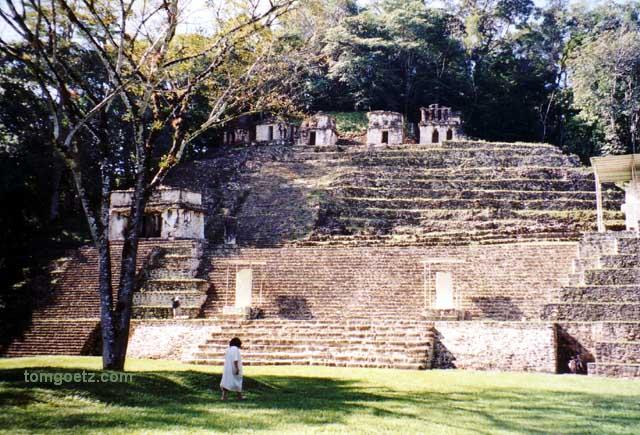
Bonampak
Three hours later we arrive at Bonampak, in the
territory of the Lacandón, the forest Maya, who until
a few decades ago had scarcely any contact with the
rest of Mexico. They were the only Maya never
conquered by the Spaniards, and thus never
Christianized by the Catholics. Traditionally, the
Lacandón do not cut their hair and wear long white
smocks of coarse cotton.
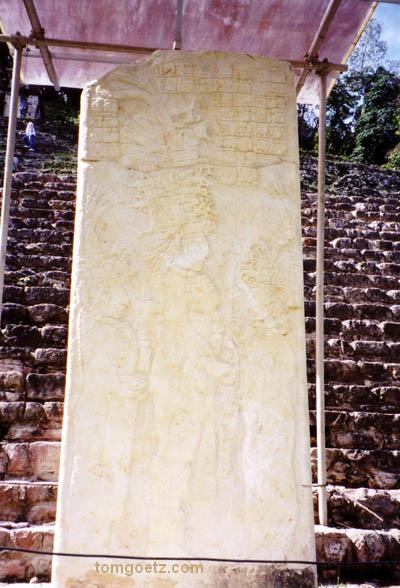
Estela
Bonampak, whose name means painted walls, is a
small site which has some of the best-preserved
murals of all the Mayan cities. Bonampak was hidden
from the outside world by dense jungle until 1946
when a young explorer became friends with a Lacandón
Maya who showed him the sacred site. It has elaborate
stelae and is still used by the Lacandón for
ceremonies.
Next we continued an hour to Frontera Corozal on
the Mexican border, went through exit immigration,
and there our group broke up. Nine of our group
crossed to Guatemala, and three of us joined some
others in a lancha (boat) and headed an hour down the
Río Usamacinta to Yaxchilán for a two-hour visit. The
lancha trip was beautiful, nothing but jungle and the
occassional Guatemalan navy troops. The Usamacinta is
as wide as the Tennessee, but undeveloped along this
stretch.
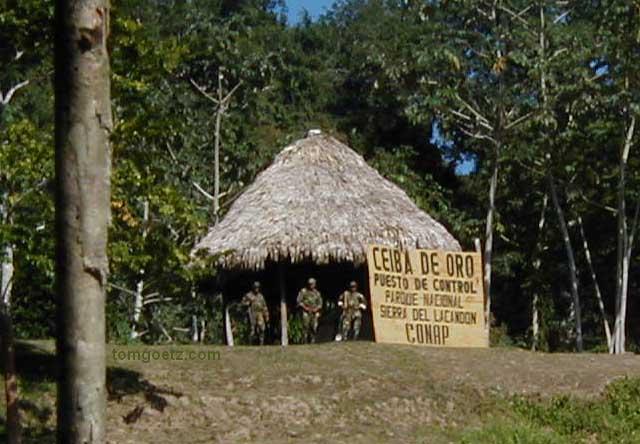
Guatemalan Navy Headquarters
Yaxchilán dominates a bend in the Usamacinta,
which gave it a powerful presence in politics and
trade along the river in its time. Instead of
pyramids, its temples and palaces are built in
terraces on steep hills above the river.
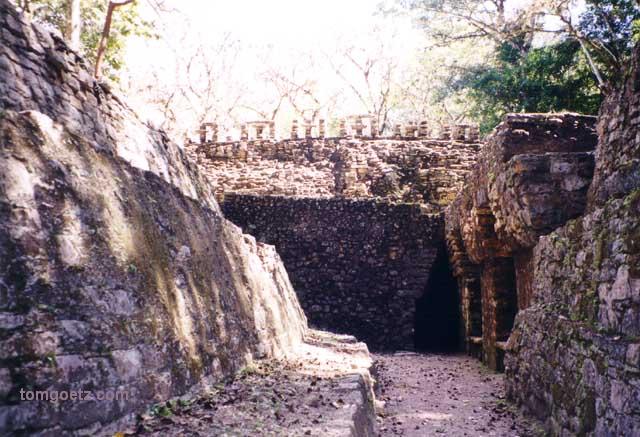
Enter the labyrinth to Yaxchilán!
Arriving on the beach below the ruins, you climb a
steep, sandy staircase to the park entrance, where
you enter the site through a pyramid, finding your
way through its dark, spooky corridors. Glad we
brought a flashlight!
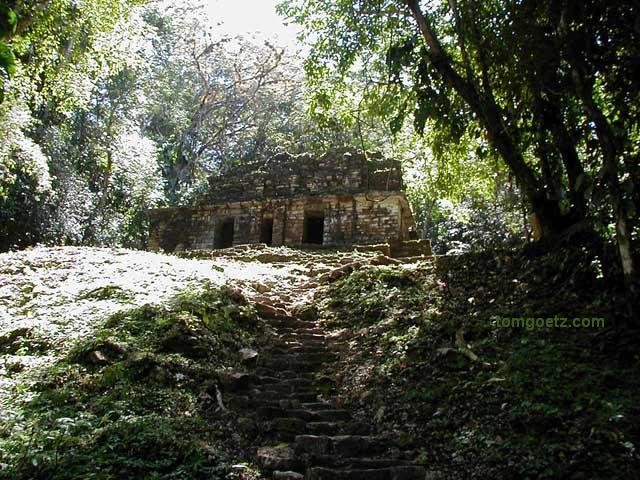
A temple of Yaxchilán
Its temples aside, the ultimate attraction of
Yaxchilán is its gorgeous rainforest location. The
site is very secluded and very lush. One gets the
sense that it could be reclaimed by the jungle at any
time. In the background is the extraordinary racket
of screaming and moaning howler monkeys. A visit here
is a must when traveling La Ruta Maya.
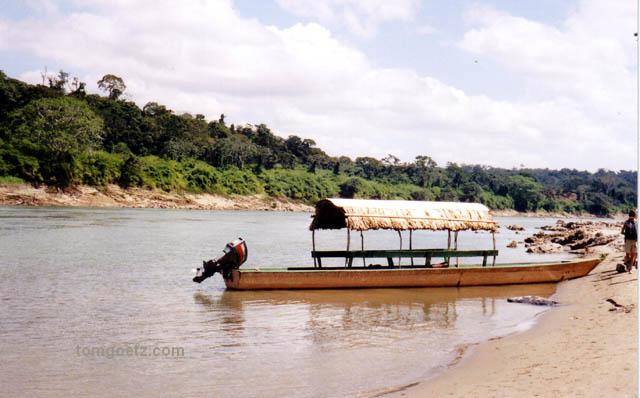
Lancha on the Usamacinta
The return upstream takes an hour and a half
against the powerful flow of the river. On the way
back, we had the extreme delight of seeing a
cocodrilo (crocodile) sunning itself on the bank of
the river. It was a big one! We also saw women
knee-deep in the water washing their clothes and
unattended children roaming the river banks. They're
not scared of crocodiles?!?
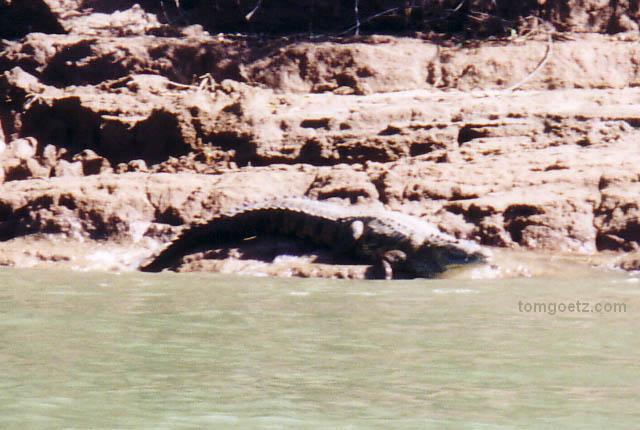
¡Peligro cocodrilo!
Back at Frontera Corozal lancheros were unloading
goods - bag after bag of chiles! We had a quick
lunch, said goodbye to the last member of our group,
a French man who was returning to Palenque, and Tom
and I embarked on another lancha trip, 30 minutes
upriver to the Guatemalan border town of Betél. Tom
and I were the only passengers.
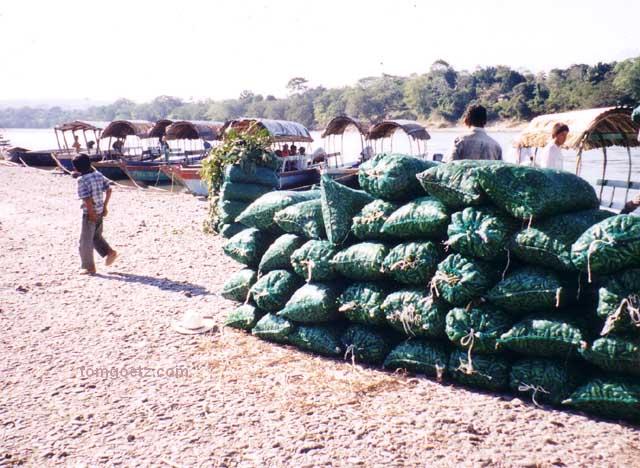
Mmmm... Jalapeños
Upon arrival in Betél, our lanchero had the
responsibility of securing our passage to Flores, our
destination. He bargained with a bus driver, who
seemed reluctant to take us, then tried to get us to
pay again. We weren't having it. He didn't press the
issue, and he paid the fare like he was supposed to.
The fare arranged for us was 80 quetzales each. The
exchange rate in Guatemala is about 7.5 quetzales per
dollar, so that's less than 11 bucks. It turned out
to be quite a bargain, as once again we were the only
passengers.
In Betél we experienced a very strange immigration
process. The "immigration office" was an unlikely
half mile down the road from the boat landing, past
pigs and chickens and mangy dogs, and it was staffed
by a woman running a tienda (a little open-air
convenience store). The tienda lady came out, had us
fill out tourist cards, and charged us five bucks
each to enter the country. She spoke English. Our bus
driver said he needed to wait 30 minutes for his
partner, then we'd go.
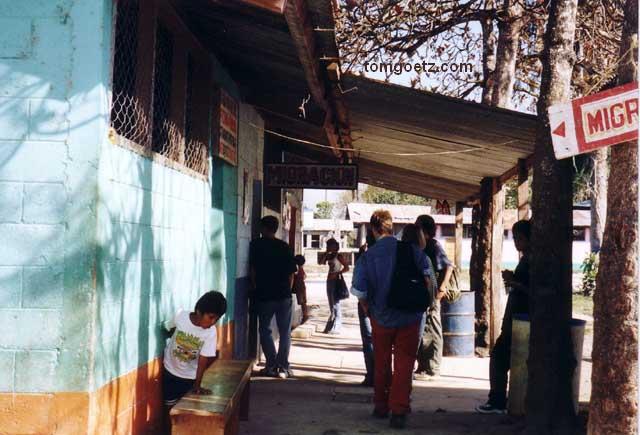
Immigration tienda
When his partner arrived, he greeted us in perfect
English and introduced himself as Jimmy. He was a
tour guide from Honduras, as was the driver. As it
turned out, they just happened to be in Betél before
returning to Honduras from guiding a tour, and the
lanchero had talked the driver into taking us to
Flores. We're sure they weren't even supposed to be
taking passengers with them. There were no other
buses around when we were there though, so I'm glad
they agreed to give us a lift.
The road from Betél is barely a road at all. It's
more like a cruel joke. It is a rough path recently
scraped through the slash-and-burn. It's dirt, but
compact and dry as concrete. I've never seen so much
dust in my life. The ride just about rattled the
fillings out of my teeth. We are in the department of
El Petén, which occupies fully one-third of
Guatemala. We are about 150 miles north of Guatemala
City. Until 1970 the entire region of the Petén was
virtually inaccessible by road. The trip to Flores
took three and a half hours. We arrived at 8:50
p.m.
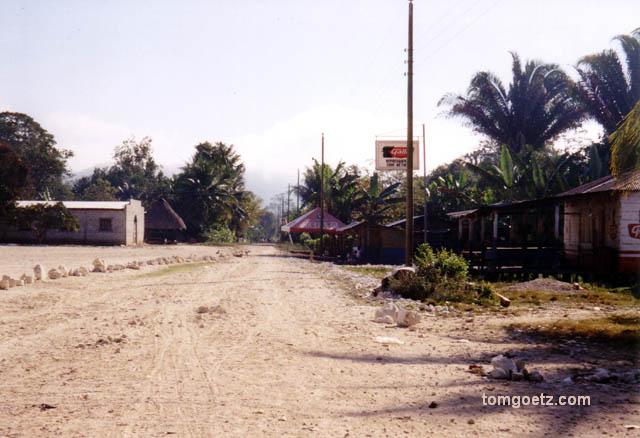
The "road" from Betél - before it gets rough
Our room for the next three nights is at the Hotel
El Itzá, 150 quetzales ($20) per night, very
comfortable, but little character. It would have been
only 100Q, but we opted to turn on the air
conditioning. It was like a sauna in this town and we
had no window. Be serious. There are no ATMs in
Flores, so we changed money at a travel agency. We
were tired and sore from our big day and decided to
take it easy tomorrow.
|









